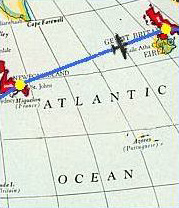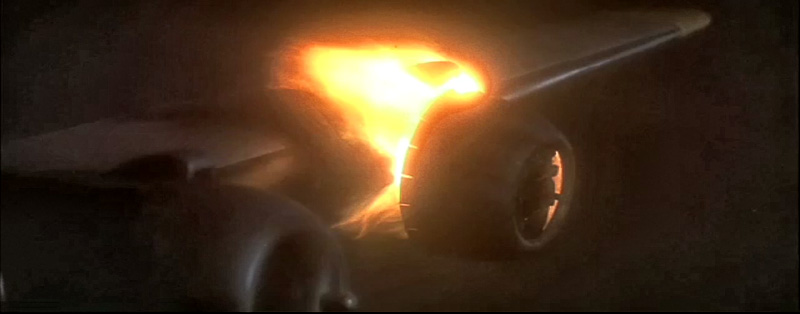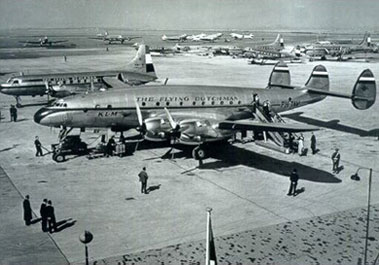Consternation on a Constellation — Flying from Curaçao to Amsterdam in 1948 (Part 4)

Finally, we were on our way across the Atlantic. Once the aircraft had reached cruising altitude, the flight attendants suggested that we have some shuteye or do some reading. Magazines were readily available.
We were provided with small pillows and a summer blanket and it was explained to us how we could recline our seats and how to use the reading lamps. Shortly after this briefing the cabin lights were dimmed. All a person could hear was the drone of the engines, some minor conversations amongst some of the passengers and the occasional snoring of the odd male passenger. All told a very comfortable environment. But the comfort would not last….
Consternation over the North Atlantic
After some four hours the drone of the engines ominously changed. The flight attendants indicated to those passengers who were awake that one engine had been feathered as some minor mechanical problems were being encountered. The problem engine was the inboard one on the left wing of the aircraft.
I was sitting by a window near the trailing edge of the left wing and I could see that the propeller of the inboard engine, the number two engine, was not moving. The propeller blades had indeed been feathered, which means they were turned edge-on into the slipsteam to reduce drag. We were told that there was nothing to worry about as the aircraft was able to fly on three engines, we were still at our assigned flight level, and in about an hour we would be landing at Prestwick Airport in Scotland.
The loss of power from the left inboard engine affected the cabin heating system and in no time the majority of the passengers were awake and shivering under the thin summer blankets. One could feel the tension amongst the passengers rise. A few of the passenger exchanged comments about the flight being jinxed. One could hear the subdued crying of a couple of the female passengers and the voices of the two flight attendants going up and down the aisle trying to comfort them.

Descending over the North Atlantic
We cruised for about a half hour, when daylight was beginning to break and we were given an update on our predicament. We were starting our descent for the Prestwick Airport. Due to the mechanical problems we only could descend a few hundred feet at a time. This would lengthen the overall descent time and we were warned that it was going to be a bumpy descent. The captain, the copilot, and the flight engineer did not want to risk any additional engine problems by executing a normal descent. Under the prevailing conditions their main concern was to keep the operating engines in the appropriate temperature range.
We had been warned that we would experience discomfort, and every few minutes we each had that sickening feeling of our seat falling from underneath our butt. It did not take long for some passengers to get airsick.
Without a doubt the descent became the most tense and nerve-wracking event of the total trip. Each sudden drop in altitude was accompanied by the outcries of small children and some female passengers; some fathers and husbands told them, none too helpfully, to "Shut up!" The sounds and smell of airsick passengers all added to a somber and dismal mood in the cabin. My stomach also rebelled against the unaccustomed situation; I was sick and frightened.
The carefully controlled descent seemed to last forever. After about an hour until we were notified that we were on final approach for the runway at Prestwick.
We arrive at Prestwick, Scotland
Once on the ground we walked to the airport terminal. It was a very dreary picture. Moments ago all of us had been in a very apprehensive mood about ever reaching the ground again alive and well. We were cold due to the lack of adequate heat in the cabin for the last hours of our flight. We were walking in a soggy rain typical for that part of Scotland towards some gray airport terminal buildings with moss protruding from the corners of the roof tiles and the gutters. Hot drinks and breakfast were made available to us.
Once again the mechanical problems of the airplane were being addressed. Engine cowlings were being removed and tarps were put into position so that the mechanics could work on the airplane without being soaked by that soggy rain. It was obvious that the Royal Dutch Airlines had flown in some aircraft maintenance engineers from Schiphol Airport while we were on our long and nerve-wracking descent into Prestwick.
Amsterdam, at last!
We spent about two and half hours at Prestwick Airport waiting for the airplane to be fixed for our last short leg to the Schiphol Airport. We were barely in the air and did not even get a chance to unbuckle our seat belts when we were told that we were on the approach path to our final destination.
Once inside Schiphol Airport all the passengers collected their baggage and proceeded to go through the necessary formalities with the immigration and customs officers.

Some of the passengers momentarily grouped together to reminisce about the new air travel mode, our safe arrival, and the time it took for the total trip — just short of 27 hours. Calculations were being made to see how much time it would take for a normal trip without technical delays.
The comforts and discomforts of flying were discussed and a comparison was made to the customary three-week boat trip. The overall conclusion was that while the boat trip was very relaxing, air travel was a more effective way to get to your destination and make the most of a family visit or sightseeing vacation. Those who had flown on the DC-3, which was a popular aircraft in those years, also gave the Constellation a high approval rating.
Next, in Part 5: Looking back more than 50 years to his family’s stressful flight from Curaçao to Amsterdam, considering his own experience as a commercial pilot, Ben offers his compliments to KLM for its professionalism, and considers how the media might cover such an interrupted flight in these days of “news as entertainment”.